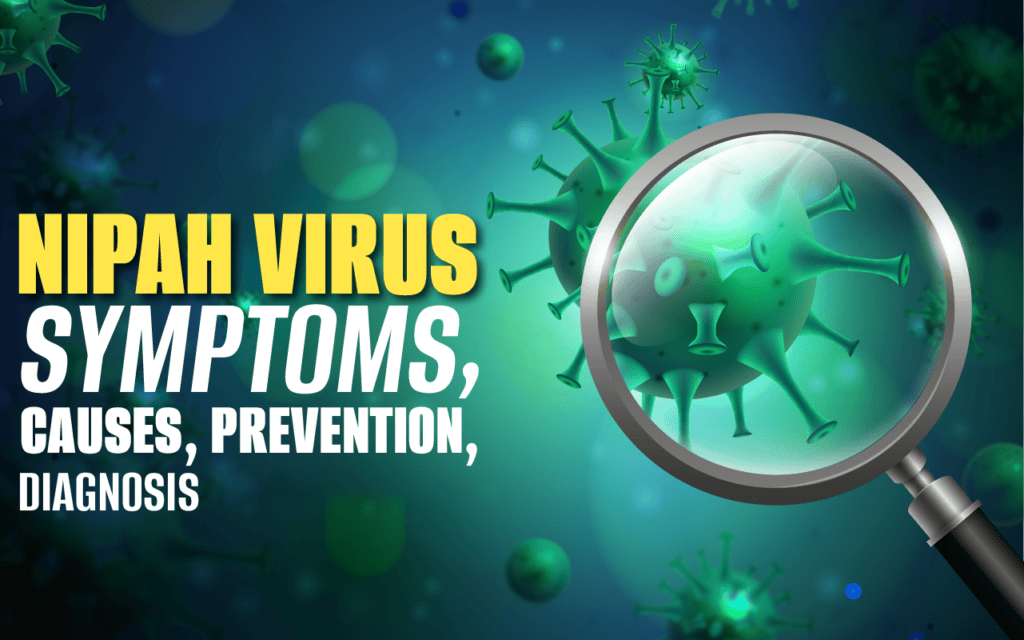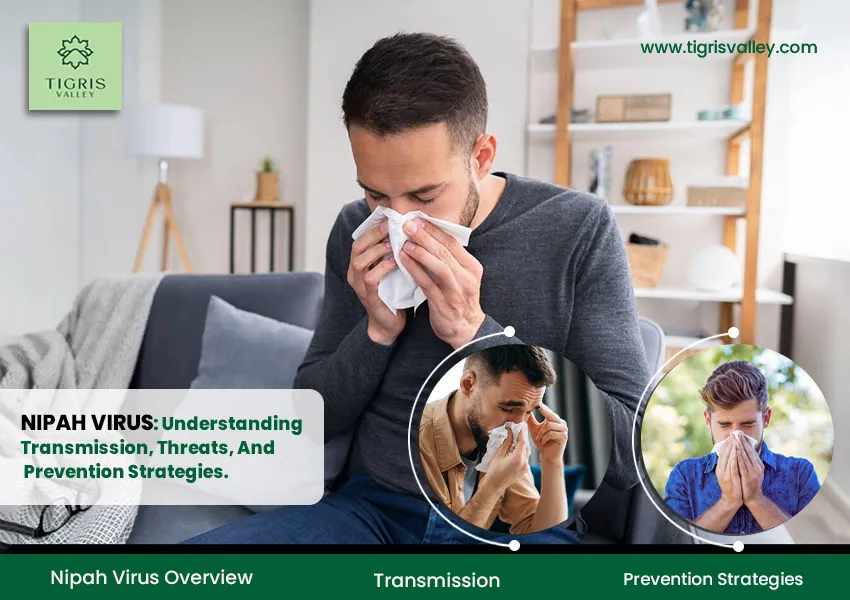Nipah Virus: Understanding Transmission, Threats, and Prevention Strategies
Nipah virus (NiV) is a zoonotic virus, which can spread between animals and humans. It was
first identified during an outbreak in Malaysia and Singapore in 1998-1999. The virus caused
severe respiratory illness in pigs and encephalitis (inflammation of the brain) in humans,
leading to significant mortality.
Origins and Transmission of Nipah Virus
The Nipah virus belongs to the Henipavirus genus, a group of viruses in the family
Paramyxoviridae. The natural reservoir for the Nipah virus is fruit bats of the Pteropodidae family,
particularly species belonging to the genus Pteropus. Transmission to humans can occur
through:
Human-Animal Interaction: Close contact with infected bats or pigs, either directly
or through their bodily fluids, can lead to the transmission of the virus. In Malappuram,
it is suspected that the initial cases were linked to bat-to-human transmission.
Contaminated Food: Consumption of fruits or fruit products (such as raw date palm
sap) contaminated with saliva or urine from infected bats can also spread the virus. This
route is particularly relevant in regions where such practices are common.
Human-to-Human Transmission: Once the virus infects a human, it can spread to
others through direct contact with the infected person’s bodily fluids, such as saliva,
urine, or respiratory droplets. This secondary transmission has contributed to the spread
of the virus in the community.
Symptoms and Clinical Features of Nipah Virus Infection

The incubation period (time from infection to the onset of symptoms) ranges from 4 to 14 days.
Initial symptoms include fever, headache, dizziness, and vomiting. As the disease progresses,
it can lead to severe respiratory issues and encephalitis. Symptoms of encephalitis include:
Fever
Headache
Drowsiness
Disorientation
Mental confusion
Respiratory symptoms such as cough and shortness of breath
Seizures (in severe cases)
In severe cases, the infection can lead to encephalitis (inflammation of the brain), resulting in
coma and death. The incubation period typically ranges from 4 to 14 days.
Diagnosis
Diagnosis of Nipah virus infection can be confirmed through laboratory tests such as:
Real-time polymerase chain reaction (RT-PCR) from throat and nasal swabs,
cerebrospinal fluid, urine, and blood.
ELISA (enzyme-linked immunosorbent assay) to detect NiV-specific antibodies.
Treatment and Prevention
There is no specific antiviral treatment for Nipah virus infection. Treatment is supportive and
focuses on managing symptoms. Intensive supportive care is essential, particularly in severe
cases with respiratory and neurological complications.
Prevention strategies include:
Avoiding Contact: With sick animals, particularly pigs and bats.
Consuming Safe Food: Avoiding consumption of raw date palm sap and ensuring food
hygiene.
Protective Measures: In healthcare settings, use of personal protective equipment
(PPE) to prevent nosocomial transmission.
Public Health Education: Raising awareness about avoiding contact with bats,
consuming only pasteurized fruit products, and practicing good hygiene can prevent
infection.
Surveillance and Reporting: Strengthening surveillance systems to identify quickly
and respond to outbreaks.
Management and Control Measures

Effective management and control of the Nipah virus outbreak involve several strategies:
Early Detection and Isolation: Rapid identification and isolation of suspected cases
are crucial to prevent further spread. Health authorities have implemented screening
and testing protocols to identify infected individuals promptly.
Contact Tracing: Extensive contact tracing efforts are underway to identify and
monitor individuals who have been in close contact with confirmed cases. This helps
in the early detection and isolation of secondary cases.
Quarantine and Isolation Facilities: Dedicated quarantine and isolation facilities have
been established to care for infected individuals and prevent transmission to others.
Public Awareness and Education: Public health campaigns are being conducted to
educate the community about the symptoms, transmission routes, and preventive
measures. This includes advising people to avoid consuming potentially contaminated
fruits and to practice good hygiene.
Personal Protective Equipment (PPE): Healthcare workers and those involved in
managing the outbreak are provided with appropriate PPE to protect themselves from
infection.
Travel Restrictions and Movement Control: Temporary travel restrictions and
movement controls have been implemented in affected areas to limit the spread of the
virus.
Animal Surveillance and Control: Surveillance of animal populations, particularly
bats and pigs, is being conducted to identify and manage potential sources of infection.
Research and Development: Efforts are ongoing to develop vaccines and antiviral
treatments for Nipah virus. While no specific treatment currently exists, supportive care
and management of symptoms are provided to patients.
Outbreaks and Public Health Impact

Since its discovery, Nipah virus has caused several outbreaks, predominantly in South and
Southeast Asia. Notable outbreaks have occurred in:
Malaysia and Singapore (1998-1999): Resulted in over 100 human deaths and the
culling of over a million pigs.
Bangladesh and India (since 2001): Regular outbreaks with high fatality rates, are often
linked to consumption of contaminated date palm sap.
Nipah virus poses a significant public health threat due to its high mortality rate, potential for
human-to-human transmission, and lack of specific treatment. Continued surveillance,
research, and public health measures are crucial to managing and mitigating the risk of Nipah
virus outbreaks.
Conclusion
Nipah virus remains a deadly pathogen with significant implications for public health.
Understanding its transmission dynamics, enhancing diagnostic capabilities, and implementing
robust prevention strategies are key to controlling future outbreaks and protecting public health.

